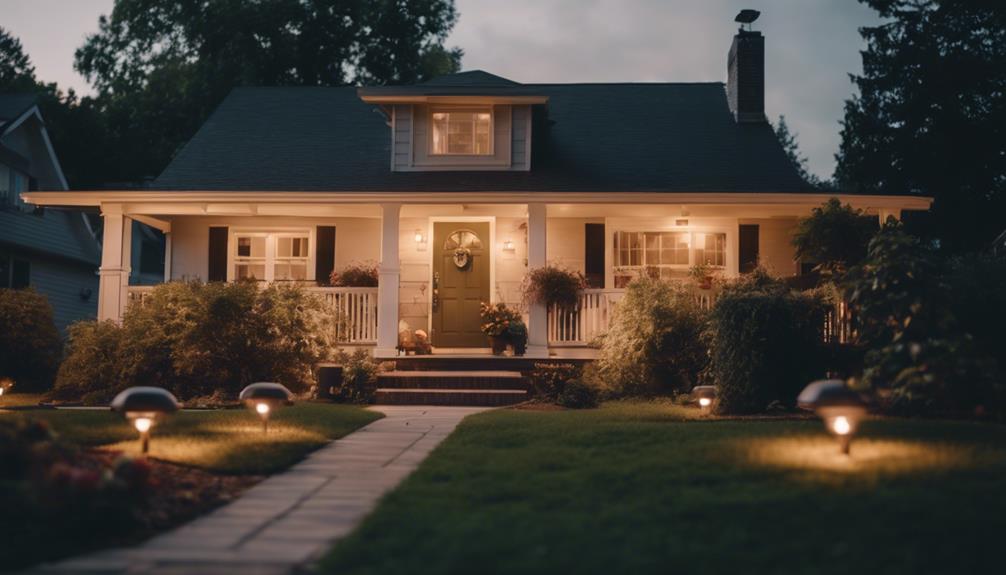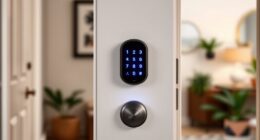To deactivate your home security system, quickly input your correct PIN or master code on the control panel or app within the designated entry delay period, typically around 30 seconds. Pay attention to the beeping noise, as it signifies the need for action. If the alarm continues, verify your code for any mistakes and ensure the system is receiving power. Additionally, consider referring to your user manual for specific guidance. If issues persist, there are further steps you can take to ensure a smooth disarmament process and improve your overall security experience.
Key Takeaways
- Enter the valid PIN or master code on the control panel or app within the entry delay period to disarm the system.
- If the alarm does not disarm, check the accuracy of the entered code and ensure the power supply is functioning.
- Use designated entry doors to activate entry delay, prompting the system to emit beeping sounds.
- Consider using mobile apps or voice commands for remote or hands-free disarming options.
Disarming Procedures
To disarm your home security system, enter your valid PIN or master code on the control panel or app within the entry delay period, usually about 30 seconds. Most systems emit a beeping sound during this time, reminding you to act quickly. Once you enter the correct alarm code, the system will stop beeping, and the sensors will be disabled, giving you peace of mind.
If your attempt to disarm the system fails, first double-check the code you entered. If it's correct, consider potential issues like low battery power or a malfunctioning transformer. Replacing batteries might resolve the problem if it's a wireless system. For wired systems, you might need to use a specific command, like [Master Code] + [1], to disarm.
Should you encounter any challenges, it's a good idea to consult your user manual. This resource can provide tailored instructions for your specific alarm system, helping you navigate any troubleshooting steps effectively.
Following these procedures will guarantee you successfully disarm the system and maintain your home's security.
Initial Steps for Disarming

Entering through the designated entry door activates the entry delay, giving you about 30 seconds to disarm the system. During this time, you'll hear beeping or chirping sounds, signaling that the system is waiting for your disarming code.
Just as maintaining a well-functioning home security system is important, guaranteeing your heat pump is running efficiently is also vital for home comfort and energy savings, especially during extreme weather conditions. For more details, check out enhancing heat pump efficiency.
To disarm the home security system, head straight to the keypad to disarm the alarm. Input your correct passcode promptly; if you enter the wrong code, the system will notify the monitoring center, which could lead to unnecessary alerts.
If the alarm doesn't disarm after entering the code, check the power supply. Verify that the backup batteries are functional and that the transformer is connected properly. Power issues can prevent the system from disarming, so it's essential to troubleshoot this before taking further steps.
Always refer to your user manual for specific disarming procedures tailored to your alarm system. Each system may have unique features or requirements, so familiarizing yourself with the manual can save you time and frustration.
Follow these initial steps carefully to guarantee a smooth disarming process.
Troubleshooting Alarm Issues

Troubleshooting alarm issues can often feel frustrating, but knowing what to check can simplify the process.
Start with the security panel; if entering your alarm code doesn't stop the alarm, it's time to check the backup batteries. Replace them to guarantee your system's proper functionality.
Additionally, employing a methodical approach can help you systematically evaluate the problem.
Next, verify that the alarm systems are receiving power. Inspect the transformer and outlet connections for any issues that might be interrupting functionality.
If your alarm relies on a wired setup, verify there are no interruptions in the landline connections. A faulty line can lead to unnecessary triggers.
If your alarm continues to go off without a valid reason, consult the user manual for troubleshooting steps specific to your system model.
Alarm Code Considerations

When it comes to alarm codes, having a unique code is essential for keeping your home secure. This is similar to how employers conduct background checks to verify candidate information and guarantee safety.
You should also consider alternatives to traditional codes that can enhance safety and accessibility for your guests. Understanding these options will help you manage your security system more effectively.
Importance of Unique Codes
Unique alarm codes play an essential role in enhancing your home security by making it harder for intruders to gain access. By using unique alarm codes, you greatly reduce the risk of unauthorized access, keeping your home and loved ones safer.
To further bolster your home safety, consider employing smart organization techniques that help you maintain a clutter-free environment, which can also deter potential intruders.
Here are some key considerations for managing your alarm codes effectively:
- Use unique alarm codes that are hard to guess.
- Assign individual codes for family members and guests to track who enters your home.
- Store codes securely, avoiding easily accessible places to prevent compromise.
Implementing these practices helps guarantee that your home remains protected.
Remember, the goal is to make it as difficult as possible for unauthorized individuals to bypass your security system.
By assigning individual codes and changing them regularly, you maintain control over who can access your system, adding an extra layer of protection.
Understanding the importance of unique codes will empower you to take proactive steps in managing your home security effectively.
Alternatives to Traditional Codes
Exploring alternatives to traditional alarm codes can enhance your home security while offering more convenient access methods.
Many modern systems allow you to disarm your alarm using mobile apps, enabling remote control without needing to remember a numeric code. This wireless security option is user-friendly and often comes with customizable settings through your alarm company's app.
Additionally, guaranteeing good indoor air quality with devices like air purifiers can create a healthier living environment, which is essential for overall well-being the importance of air purifiers.
Voice command functionalities can also streamline the process, letting you disarm your system hands-free. However, use this feature with caution due to potential security risks.
Additionally, consider setting up unique codes for family members or guests, which not only boosts security but also helps you track who accesses your home.
For added safety, some systems offer a duress code that discreetly notifies the monitoring center without alarming an intruder.
Finally, biometric options like fingerprint scanners or facial recognition are gaining popularity, providing a secure and effortless way to disarm your alarm.
When choosing any of these alternatives, always review the privacy policy of your alarm company to guarantee your data is protected.
Seeking Assistance

If you find yourself struggling to disarm your home security system, reaching out for help can make the process much smoother. A cozy environment, like a cottagecore home office, can also help you stay calm while troubleshooting.
Don't hesitate to seek assistance when needed. Consider these options:
- User Manual: Refer to your device's user manual for specific disarming procedures tailored to your model.
- Alarm Company: Contact your alarm company for expert guidance and troubleshooting assistance.
- Customer Support: Many security systems provide 24/7 customer support to help you through the disarming process.
Consulting with your alarm provider is particularly important if you experience frequent false alarms. They can help you identify potential issues or recommend necessary reprogramming.
Taking these steps not only aids in disarming your security system but also guarantees that it continues to provide the protection you need. Remember, it's always better to ask for assistance rather than risk compromising your home's security. Your peace of mind is worth it.
Security System Costs

When you're contemplating a home security system, understanding the costs involved is essential.
You'll find that average system pricing, installation expenses, and monitoring fees can vary widely.
Additionally, many homeowners opt for customizable security packages that can impact overall pricing.
It's also wise to reflect on what to look for in a home cleaning service to guarantee you maintain a clean environment that complements your security measures.
Let's break down these key components to help you make an informed decision.
Average System Pricing
Home security systems typically range in price from $200 to $1,500, depending on the features and technology you choose. When evaluating options, consider the following factors that can impact your overall investment:
- Type of alarm: Basic systems might be less expensive, while advanced home alarm systems with smart technology will cost more.
- Monitoring services: Monthly fees for professionally monitored systems usually range from $15 to $60, which adds to your budget.
- Smart devices: Adding smart locks or cameras can increase your expenses by $100 to $300 each, enhancing your security.
Installation Expense Breakdown
Understanding the installation expenses associated with your home security system is essential for making an informed decision. The cost of security systems can range from $200 to $1,500, depending on the complexity and features you choose.
If you prefer a hands-on approach, a DIY installation can save you money, while professional installation typically adds to your total expense.
Smart devices like cameras and locks can enhance your system but also impact your budget considerably. For instance, smart cameras usually cost between $100 and $300 each.
Additionally, be aware of other potential costs, such as permit fees and maintenance expenses, which can vary based on local regulations.
You'll also need to evaluate the power requirements of your system. Some devices may require battery replacements, adding to your yearly costs.
By breaking down these expenses, you can better assess your options and find a security solution that fits your budget.
Keep in mind that while initial costs are important, reflecting on the long-term maintenance and functionality of your system will ultimately help you make the best choice.
Monitoring Fee Overview
Monthly monitoring fees for security systems can markedly affect your budget, typically ranging from $15 to $60 based on the service level and features you choose. When evaluating home security systems, it's important to grasp what these fees cover and how they fit into your overall expenses.
Here are some key points to reflect on:
- Basic Services: Usually include 24/7 surveillance and emergency response.
- Advanced Packages: Often provide smart home integration and mobile app access.
- Contract Discounts: Some companies offer savings for long-term agreements or bundling services.
Keep in mind that professional installation might come with separate costs, and while DIY options can save you money upfront, they may lack the support you need later.
Carefully assess your needs and budget to find the most suitable monitoring service for your home security system. Understanding these monitoring fees and additional costs will help you make an informed decision and guarantee your home remains well-protected.
Installation and Maintenance

Effective installation and maintenance of your security system are vital for guaranteeing peak performance and reliability.
Start by selecting ideal camera locations to maximize coverage and visibility. If you're installing outdoor cameras, choose weatherproof models and mount them at least 8-10 feet above ground to reduce tampering risks. Don't forget about guaranteeing a stable power supply for both wired and wireless components.
Once everything's installed, regular maintenance is key. Clean your camera lenses routinely to guarantee clear footage, and keep an eye on battery levels to prevent any interruptions. Make sure you familiarize yourself with the instruction manual for each camera model; it can provide significant installation instructions and troubleshooting tips to resolve common issues quickly.
Additionally, be aware of local regulations, as some areas may require permits for security system installation. This could impact the overall cost and legality of your setup.
Security Alarm Vulnerabilities

Many homeowners overlook potential vulnerabilities in their security alarm systems that could be exploited by intruders. To protect yourself, it's vital to be aware of these weaknesses:
- Power Outages: If your system relies solely on AC power, a power outage can render it useless without a backup.
- Insecure Codes: Storing your alarm codes insecurely can make it easy for thieves to gain unauthorized access.
- Phone Line Cuts: Cutting the phone lines disrupts communication for landline-based systems, leaving them ineffective during an intrusion.
Additionally, be mindful of false alarms. They can indicate a malfunction or low battery, prompting you to disconnect the battery. Regular maintenance and timely battery replacements are essential to guarantee your system remains functional.
Frequently Asked Questions
How Do I Turn off the Security System in My House?
To turn off your security system, enter the designated door to activate the delay. Then, input your disarm code on the keypad. If it doesn't work, check for battery or power issues.
How to Completely Turn off the ADT System?
Turning off your ADT system's like silencing a loud alarm clock. Just enter the entry door, input your Master Code on the panel, and wait for confirmation. If issues arise, check your power sources or consult customer service.
How Do I Disconnect the Power to My Security System?
To disconnect power to your security system, locate the AC power feed and safely cap the wires. Remove the backup battery, and if possible, unplug the transformer from the wall outlet for complete power shutdown.
How Do I Get My Security Alarm to Stop Beeping?
When your security alarm's beeping like a 90s dial-up modem, just enter the correct disarm code on the keypad. If it keeps beeping, check the batteries and power connections to fix the issue.
Can Disabling a Home Security System Lead to Legal Consequences?
Disabling a home security system without proper authorization can result in legal consequences. It is important to understand the proper protocols for how to turn off security systems in case of emergencies or false alarms. Failure to follow these guidelines can lead to fines, legal action, or compromised home safety.
Conclusion
Disarming your home security system doesn't have to be a hassle.
Just imagine, you're fumbling with your keys when your neighbor coincidentally walks by, knowing the exact code you need!
It's a reminder that understanding your system and keeping your code secure are essential.
By following the right procedures and troubleshooting common issues, you'll guarantee your home stays safe.
So, whether it's a simple mistake or a neighborly coincidence, always be prepared to disarm your system confidently.








